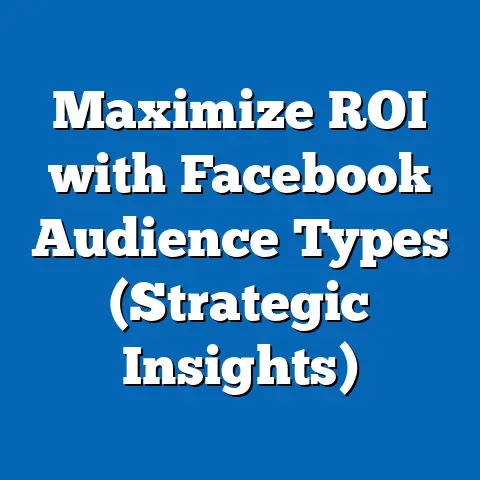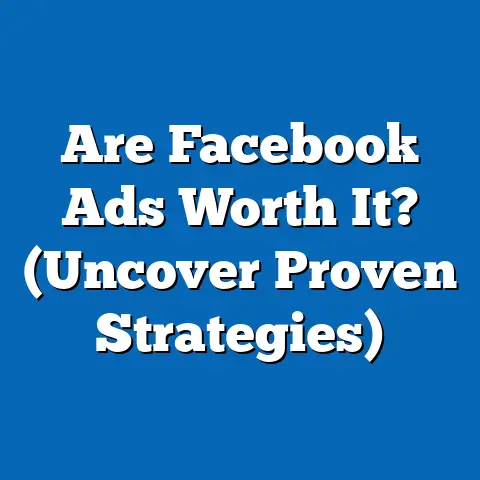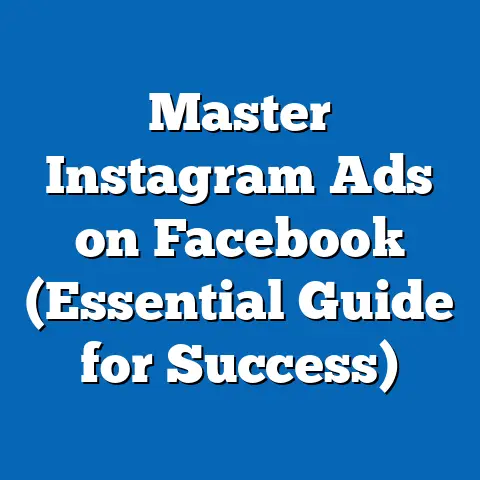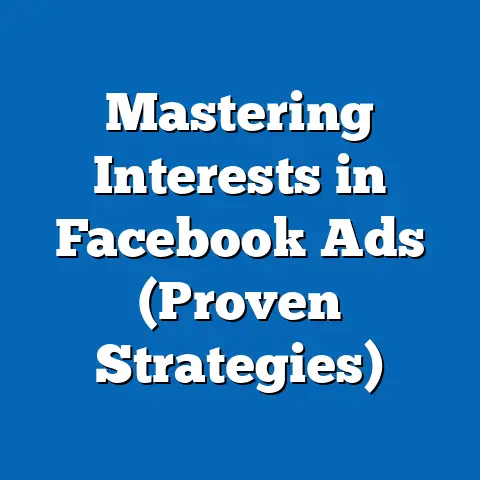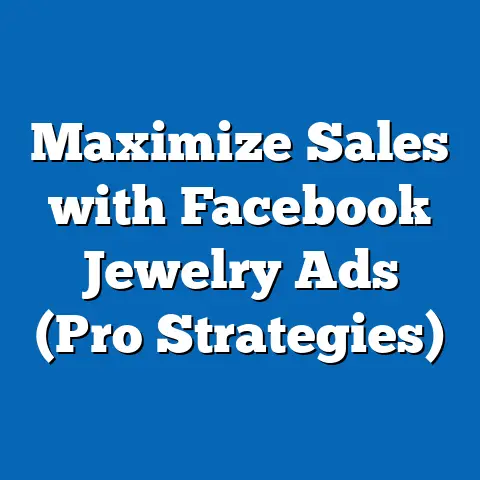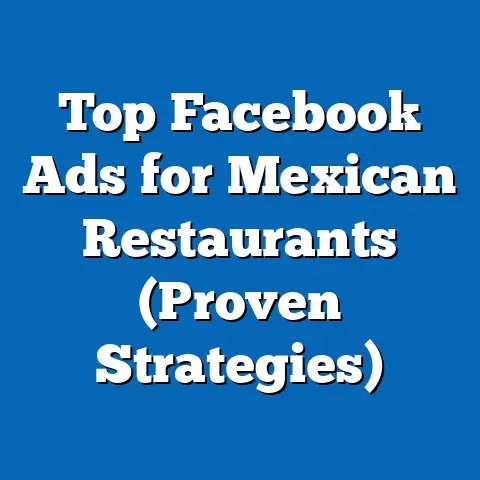Facebook Ads: Add to Cart vs. Purchase (Unlocking Success)
Facebook advertising. It’s been a constant companion in the digital marketing world for what feels like forever. Through algorithm changes, new ad formats, and the rise of other platforms, Facebook (now Meta) has remained a powerhouse for businesses looking to connect with their audience and drive sales. I remember when I first started running Facebook Ads, it felt like magic! You could target specific demographics, interests, and even behaviors. The possibilities seemed endless. And while the platform has evolved, the core principle remains the same: connect the right product with the right person at the right time.
But here’s the thing: simply running ads isn’t enough. You need to understand your metrics, and that’s where “Add to Cart” and “Purchase” come into play. As an eCommerce brand, mastering these metrics is the key to unlocking true success on Facebook. It’s not just about getting clicks; it’s about understanding the customer journey and optimizing every step of the way.
In this article, I’m going to dive deep into these two crucial metrics, explaining why they matter, how to track them, and, most importantly, how to use them to create more effective Facebook ad campaigns. I’ll share some real-world examples and insights I’ve gathered over the years, so you can take your Facebook advertising to the next level.
Understanding the Facebook Ads Ecosystem
Before we get into the nitty-gritty of “Add to Cart” and “Purchase,” let’s take a step back and look at the broader Facebook Ads ecosystem.
Facebook Ads, with its massive reach of billions of users, offers unparalleled opportunities for businesses to connect with potential customers. Think about it: almost everyone you know is on Facebook or Instagram. This vast audience, coupled with Facebook’s sophisticated targeting capabilities, makes it an incredibly powerful advertising platform.
Facebook Ads function through a system where advertisers create campaigns with specific objectives, such as driving website traffic, generating leads, or increasing sales. These campaigns are then broken down into ad sets, which define the audience you want to target, your budget, and your ad schedule. Finally, within each ad set, you have individual ads, which are the creative elements that users actually see. These can take many forms, from single image ads to video ads, carousel ads, and more.
The platform offers a wide range of targeting options, allowing you to reach people based on demographics (age, gender, location), interests (hobbies, passions), behaviors (purchase history, online activity), and even custom audiences (your existing customers or website visitors). This level of granularity is what sets Facebook Ads apart from many other advertising platforms.
Optimization is also key. Facebook’s algorithm learns from your campaigns and continuously adjusts ad delivery to maximize results. This means that the more data you feed into the system, the better it becomes at finding the right people for your ads.
The Importance of Metrics:
Now, all of this sounds great, but how do you know if your ads are actually working? That’s where metrics come in. Metrics provide a way to measure the performance of your campaigns and identify areas for improvement. Without them, you’re essentially flying blind.
There are tons of metrics available in Facebook Ads Manager, from impressions and clicks to cost-per-click (CPC) and click-through rate (CTR). But for eCommerce brands, “Add to Cart” and “Purchase” are two of the most critical. They tell you how effectively your ads are driving potential customers through the sales funnel.
Takeaway: Facebook Ads offers incredible reach and targeting capabilities, but it’s essential to understand how the platform works and to track the right metrics to measure your success.
Defining “Add to Cart” and “Purchase”
Let’s get clear on what these two metrics actually mean.
Add to Cart:
In the context of Facebook Ads, “Add to Cart” refers to the number of times someone clicks on your ad, visits your website, and adds a product to their shopping cart. It’s a key indicator of interest and intent. It signifies that a potential customer is considering purchasing your product.
Think of it as a virtual handshake. They’re saying, “I like what I see, and I’m thinking about buying it.”
Why is it important? The “Add to Cart” metric gives you valuable insights into:
- Ad Relevance: Are your ads resonating with your target audience? A high “Add to Cart” rate suggests that your ads are relevant and engaging.
- Product Appeal: Is your product appealing to the people you’re targeting? If you’re seeing a lot of “Add to Carts,” it means that people are interested in what you’re selling.
- Website Experience: Is your website easy to navigate? A good “Add to Cart” rate, but a low “Purchase” rate, may indicate issues with your website’s user experience.
Purchase:
“Purchase,” on the other hand, represents the final conversion goal. It’s the number of times someone completes a purchase on your website after clicking on your Facebook ad. This is the metric that ultimately drives revenue.
It’s the finish line. They’ve crossed it, and you’ve made a sale.
Why is it important? The “Purchase” metric tells you:
- Overall Campaign Effectiveness: How well are your campaigns driving sales? This is the bottom line.
- Return on Ad Spend (ROAS): Are you getting a good return on your investment? By tracking purchases, you can calculate your ROAS and determine which campaigns are the most profitable.
- Customer Acquisition Cost (CAC): How much does it cost you to acquire a new customer? This is a crucial metric for understanding the long-term profitability of your business.
The Funnel:
These two metrics are closely related and represent different stages of the customer journey. The typical funnel looks like this:
- Impressions: The number of times your ad is shown.
- Clicks: The number of times someone clicks on your ad.
- Add to Cart: The number of times someone adds a product to their cart.
- Purchase: The number of times someone completes a purchase.
According to recent statistics, the average eCommerce conversion rate (the percentage of website visitors who make a purchase) is around 2-3%. This means that for every 100 people who visit your website, only 2-3 will actually buy something. However, the “Add to Cart” rate is typically much higher, often in the range of 5-10%.
Example: Let’s say you’re running a Facebook ad campaign for a new line of organic skincare products. You get 10,000 impressions, 500 clicks, 50 “Add to Carts,” and 5 purchases.
- Your click-through rate (CTR) is 5% (500/10,000).
- Your “Add to Cart” rate is 10% (50/500).
- Your conversion rate is 1% (5/500).
This data tells you that your ads are generating interest (good CTR and “Add to Cart” rate), but your conversion rate is low. This suggests that there might be issues with your website or checkout process that are preventing people from completing their purchases.
Takeaway: “Add to Cart” and “Purchase” are two distinct but related metrics that provide valuable insights into the customer journey. Tracking both is essential for optimizing your Facebook ad campaigns and driving sales.
The Psychological Journey from Add to Cart to Purchase
Understanding the psychology behind the “Add to Cart” to “Purchase” transition is crucial for crafting effective Facebook ad strategies. What goes on in a consumer’s mind between adding an item to their cart and actually clicking that “Buy Now” button?
Several psychological factors come into play:
- Decision Fatigue: People make countless decisions every day. By the time they reach the checkout page, they might be experiencing decision fatigue, making them more likely to abandon their cart.
- Cognitive Dissonance: This refers to the mental discomfort people experience when holding conflicting beliefs or values. A customer might add an item to their cart, but then start to question whether they really need it or whether it’s worth the price.
- Loss Aversion: People tend to feel the pain of a loss more strongly than the pleasure of an equivalent gain. A customer might hesitate to complete a purchase because they’re focused on the money they’re about to spend, rather than the enjoyment they’ll get from the product.
- Urgency and Scarcity: Creating a sense of urgency or scarcity can motivate people to complete their purchases. Limited-time offers, limited quantities, or countdown timers can all be effective tactics.
- Social Proof: People are more likely to buy something if they see that others have done so. Reviews, testimonials, and social media mentions can all provide social proof.
How Facebook Ads Can Help:
Facebook Ads can be used to address these psychological factors and encourage people to complete their purchases. Here are a few strategies:
- Retargeting Ads: Show ads to people who have added items to their cart but haven’t completed their purchase. Remind them of the products they left behind and offer incentives to complete their purchase (e.g., free shipping, a discount code).
- Dynamic Ads: These ads automatically show people products they’ve viewed or added to their cart on your website. They’re highly personalized and relevant, which can increase the likelihood of a purchase.
- Compelling Ad Copy: Use persuasive language to address potential objections and highlight the benefits of your product. Focus on the value the customer will receive, rather than just the price.
- High-Quality Imagery: Use visually appealing images and videos that showcase your product in the best possible light.
- Social Proof: Include reviews, testimonials, and social media mentions in your ads to build trust and credibility.
- Urgency and Scarcity: Create a sense of urgency by offering limited-time discounts or highlighting limited quantities.
Example: I once ran a retargeting campaign that specifically targeted people who had added a particular item to their cart but hadn’t purchased it. The ad copy was simple: “Still thinking about that [product name]? Get it now and enjoy free shipping!” We saw a significant increase in conversions from that campaign because it directly addressed the customer’s hesitation and offered a compelling incentive.
Takeaway: Understanding the psychological factors that influence the “Add to Cart” to “Purchase” transition is essential for creating effective Facebook ad campaigns. By using retargeting, dynamic ads, compelling ad copy, and social proof, you can encourage people to complete their purchases.
Analyzing Data: The Importance of Tracking Both Metrics
Tracking both “Add to Cart” and “Purchase” metrics is like having two pieces of a puzzle that, when combined, reveal a complete picture of your ad campaign’s performance. Ignoring one is like trying to navigate with only one eye – you might get somewhere, but you’ll lack depth perception.
Why Track Both?
- Identify Bottlenecks: By comparing the “Add to Cart” rate with the “Purchase” rate, you can identify where potential bottlenecks exist in your sales funnel. A high “Add to Cart” rate but a low “Purchase” rate suggests problems with your website’s checkout process, shipping costs, or payment options.
- Optimize Ad Spend: Understanding the relationship between these metrics allows you to allocate your ad budget more effectively. If you’re seeing a lot of “Add to Carts” but few purchases, you might want to focus on optimizing your website or retargeting those who abandoned their carts.
- Refine Targeting: Analyzing the demographics and interests of people who “Add to Cart” but don’t purchase can help you refine your targeting and reach more qualified leads.
- Improve Website Experience: By tracking these metrics, you can gain valuable insights into how people are interacting with your website. This information can be used to improve the user experience and increase conversion rates.
Key Performance Indicators (KPIs):
Here are some KPIs to track for each metric:
Add to Cart:
- Add to Cart Rate: (Number of “Add to Carts” / Number of Clicks) x 100. This tells you the percentage of people who clicked on your ad and added a product to their cart.
- Cost Per Add to Cart: Total Ad Spend / Number of “Add to Carts.” This tells you how much it costs you to get someone to add a product to their cart.
Purchase:
- Conversion Rate: (Number of Purchases / Number of Clicks) x 100. This tells you the percentage of people who clicked on your ad and completed a purchase.
- Cost Per Purchase: Total Ad Spend / Number of Purchases. This tells you how much it costs you to acquire a customer.
- Return on Ad Spend (ROAS): (Revenue Generated from Ads / Total Ad Spend). This tells you how much revenue you’re generating for every dollar you spend on ads.
Case Study:
Let’s say you’re running a Facebook ad campaign for a clothing store. You notice that your “Add to Cart” rate is high (8%), but your conversion rate is low (1%). This tells you that people are interested in your products, but something is preventing them from completing their purchases.
After analyzing your website data, you discover that your shipping costs are higher than your competitors, and your checkout process is cumbersome. You decide to lower your shipping costs and simplify your checkout process. As a result, your conversion rate increases to 3%, and your ROAS improves significantly.
Takeaway: Tracking both “Add to Cart” and “Purchase” metrics is essential for identifying bottlenecks, optimizing ad spend, refining targeting, and improving website experience. By analyzing these metrics, you can make data-driven decisions that will improve your campaign performance and drive sales.
Strategies to Optimize for Add to Cart and Enhance Purchases
Now that we understand the importance of tracking both “Add to Cart” and “Purchase” metrics, let’s discuss some strategies for optimizing them.
Optimizing for Add to Cart:
- Target the Right Audience: Make sure you’re targeting people who are actually interested in your products. Use Facebook’s targeting options to reach people based on demographics, interests, behaviors, and custom audiences.
- Create Compelling Ads: Use high-quality images and videos that showcase your products in the best possible light. Write persuasive ad copy that highlights the benefits of your products and addresses potential objections.
- Use Relevant Ad Formats: Experiment with different ad formats to see what works best for your audience. Carousel ads, collection ads, and instant experience ads can all be effective for driving “Add to Carts.”
- Optimize Landing Pages: Make sure your landing pages are relevant to your ads and that they provide a seamless user experience. Use clear calls to action and make it easy for people to add products to their cart.
Enhancing Purchases:
- Retargeting Ads: Show ads to people who have added items to their cart but haven’t completed their purchase. Remind them of the products they left behind and offer incentives to complete their purchase (e.g., free shipping, a discount code).
- Dynamic Ads: These ads automatically show people products they’ve viewed or added to their cart on your website. They’re highly personalized and relevant, which can increase the likelihood of a purchase.
- Simplify the Checkout Process: Make it as easy as possible for people to complete their purchases. Reduce the number of steps in the checkout process, offer multiple payment options, and provide clear instructions.
- Offer Free Shipping: Free shipping is a powerful incentive that can significantly increase conversion rates.
- Provide Excellent Customer Service: Make sure you’re providing excellent customer service to address any questions or concerns that people may have.
Example: I worked with an eCommerce client who was struggling with a low conversion rate. After analyzing their data, we discovered that their checkout process was too complicated and that their shipping costs were too high. We simplified their checkout process and offered free shipping on orders over $50. As a result, their conversion rate increased by 50%, and their revenue doubled.
Takeaway: By implementing these strategies, you can optimize your “Add to Cart” rate and enhance your purchase rate, ultimately driving more sales and revenue for your business.
Real-World Examples and Case Studies
Let’s take a look at some real-world examples of brands that have successfully navigated the “Add to Cart” and “Purchase” journey through Facebook Ads.
- Example 1: A Fashion Retailer: This retailer used retargeting ads to show people products they had viewed on their website. The ads featured high-quality images of the products and included a discount code for 10% off. As a result, they saw a 30% increase in conversion rates and a 20% increase in revenue.
- Example 2: A Beauty Brand: This brand used dynamic ads to show people products they had added to their cart but hadn’t purchased. The ads were personalized to show the specific products that each person had left behind. As a result, they saw a 40% increase in conversion rates and a 25% increase in revenue.
- Example 3: A Home Goods Store: This store used carousel ads to showcase a variety of products in a single ad. The ads were targeted to people who had expressed an interest in home decor. As a result, they saw a 20% increase in “Add to Carts” and a 15% increase in revenue.
Common Themes:
Across these case studies, there are a few common themes:
- Personalization: Personalized ads are more effective than generic ads.
- Retargeting: Retargeting ads are a powerful way to reach people who have already expressed an interest in your products.
- Incentives: Offering incentives, such as free shipping or discount codes, can significantly increase conversion rates.
- Seamless User Experience: A seamless user experience is essential for driving sales.
Takeaway: These real-world examples demonstrate the power of using Facebook Ads to drive “Add to Carts” and purchases. By implementing the strategies discussed in this article, you can achieve similar results for your own business.
Future Trends in Facebook Ads Related to Add to Cart and Purchase
The world of Facebook Ads is constantly evolving. New features, technologies, and consumer behaviors are emerging all the time. So, what does the future hold for “Add to Cart” and “Purchase” optimization?
Here are a few trends to watch:
- AI and Machine Learning: AI and machine learning are becoming increasingly important in Facebook Ads. These technologies can be used to automate tasks, personalize ads, and optimize campaigns in real-time.
- Personalization: Personalization will continue to be a key trend in Facebook Ads. Consumers are demanding more personalized experiences, and advertisers who can deliver will be rewarded.
- Augmented Reality (AR): AR is starting to make its way into Facebook Ads. AR ads allow people to virtually try on clothes, see how furniture would look in their home, and more. This can be a powerful way to increase engagement and drive sales.
- Voice Commerce: Voice commerce is on the rise. As more people use voice assistants like Alexa and Google Assistant, advertisers will need to find new ways to reach them through voice ads.
Takeaway: By staying on top of these trends, you can ensure that your Facebook ad campaigns are always optimized for success.
Conclusion
Understanding the “Add to Cart” and “Purchase” metrics in Facebook Ads is essential for eCommerce brands that want to drive sales and revenue. By tracking these metrics, you can identify bottlenecks, optimize ad spend, refine targeting, and improve website experience.
While the landscape of digital advertising continues to evolve, the principles of effective targeting, compelling messaging, and data-driven decision-making remain essential for unlocking success in Facebook Ads campaigns. Remember to test, analyze, and iterate. The Facebook Ads platform is a powerful tool, and with a little effort, you can harness its potential to grow your business.
I’ve shared my experiences, insights, and strategies in this article, and I hope they’ve been helpful. Now it’s your turn to put them into practice and see what you can achieve. Happy advertising!

